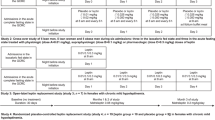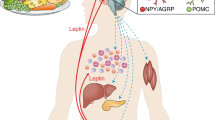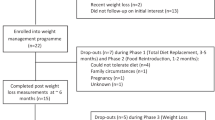Abstract
OBJECTIVE: The effects of short-term moderate physiological changes in energy flux and energy balance, by exercise and over- or underfeeding, on a 24 h plasma leptin profile, were investigated.
DESIGN: Subjects were studied over 24 h in four randomized conditions: no exercise\energy balance (energy intake (EI)=;energy expenditure (EE)=;11.8±0.8 MJ); exercise\energy balance (EI=;EE=;15.1±0.6 MJ); exercise\negative energy balance (EI=;11.8±0.8 MJ, EE=;15.1±0.8 MJ); exercise\positive energy balance (EI=;18.6±0.7 MJ, EE=;15.1±0.6 MJ).
SUBJECTS: Eight healthy, lean men (age: 23.5±7.0 y, body fat 14.1±5.4%, body mass index (BMI): 21.4±2.3 kg\m2).
MEASUREMENTS: Blood was sampled every hour during the daytime (09.00–23.00 h) and every two hours during the night (01.00–09.00 h) for analysis of plasma leptin, insulin, glucose, FFA and catecholamines.
RESULTS: Plasma leptin levels were highest around 01.00 h (mean±s.e.m. 4.9±2.0 ng\ml) and lowest around 11.00 h. (2.3±0.7 ng\ml). An increased 24 h EE, induced by exercise under conditions of energy balance, significantly decreased the peak and average 24 h plasma leptin concentration. A positive energy balance, by overfeeding, resulted in a significantly higher amplitude of the 24 h plasma leptin curve, compared to a condition of energy balance.
CONCLUSION: Exercise decreases peak and average 24 h plasma leptin concentration and a moderately positive energy balance increases the amplitude of the 24 h plasma leptin profile. These effects are not acute, but are manifest within 24 h. The variations of average 24 h FFA and average 24 h glucose concentrations almost fully explained the variation in average 24 h leptin concentration across trials.
This is a preview of subscription content, access via your institution
Access options
Subscribe to this journal
Receive 12 print issues and online access
$259.00 per year
only $21.58 per issue
Buy this article
- Purchase on Springer Link
- Instant access to full article PDF
Prices may be subject to local taxes which are calculated during checkout
Similar content being viewed by others
Author information
Authors and Affiliations
Rights and permissions
About this article
Cite this article
van Aggel-Leijssen, D., van Baak, M., Tenenbaum, R. et al. Regulation of average 24 h human plasma leptin level; the influence of exercise and physiological changes in energy balance. Int J Obes 23, 151–158 (1999). https://doi.org/10.1038/sj.ijo.0800784
Received:
Revised:
Accepted:
Published:
Issue Date:
DOI: https://doi.org/10.1038/sj.ijo.0800784
Keywords
This article is cited by
-
Highlighting the idea of exerkines in the management of cancer patients with cachexia: novel insights and a critical review
BMC Cancer (2023)
-
Leptin polymorphism rs3828942: risk for anxiety disorders?
European Archives of Psychiatry and Clinical Neuroscience (2021)
-
Evaluation of leptin, thought as a cancer-related biomarker, in postmenopausal women
Cancer Causes & Control (2015)
-
Genetic Variation in the Leptin Receptor Gene, Leptin, and Weight Gain in Young Dutch Adults
Obesity Research (2003)
-
Plasma leptin is influenced by diet composition and exercise
International Journal of Obesity (2003)



